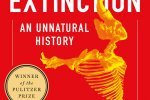
Resources
The Sixth Extinction
Category Library
Title
The Sixth Extinction
Author(s)
Elizabeth Kolbert
Year
2014
Publisher
Bloomsbury
Number of pages
319
The Sixth Extinction: An Unnatural History
Over the last half a billion years, there have been five mass extinctions of life on earth. Scientists around the world are currently monitoring the sixth, predicted to be the most devastating extinction event since the asteroid impact that wiped out the dinosaurs. Elizabeth Kolbert combines brilliant field reporting, the history of ideas and the work of geologists, botanists and marine biologists to tell the gripping stories of a dozen species - including the Panamanian golden frog and the Sumatran rhino - some already gone, others at the point of vanishing. The sixth extinction is likely to be mankind's most lasting legacy and Elizabeth Kolbert's book urgently compels us to rethink the fundamental question of what it means to be human.
Librarian's comments:
A number of the books on the FaSCoRe shelf relate to the climate and the environment. The mass extinction presently underway is connected to, but distinct from, problems of man-made climate change and (in all but the broadest sense) the environment. As such, not only does the issue raise different scientific questions, it also raises different religious questions. I will grant that this book is not (and never intended to be) a "science and religion" book. It offers no answers whatsoever. However, it is included here because the questions it raises are so interesting.
A summary of the situation:
Extinctions due to global warming are, on the grand scale of things, relatively easy to fix. We can reduce the amount of CO2 we put in the atmosphere by burning less fossil fuel (either because we use less energy, or because the energy we use is generated by other means) and we can increase the rate at which CO2 is removed from the atmosphere by ramping up sequestration. We (basically) know what to do and we (basically) know how to do it. We might thus be able to save the polar bear.
Extinctions due to ocean acidification are also, on the grand scale of things, relatively easy to fix. Put less CO2 in the oceans and / or take more out. We might thus be able to save coral.
Extinctions of megafauna due to human intervention are a little trickier. Sure, we can look after pandas and elephants and rhinos and tigers. But it is worth noting that human-related megafauna extinctions are not restricted to the modern age. In evolutionary history, being big has been an advantage: the benefit of being too big to eat (compare elephants and rabbits) offsets the cost of reproducing more slowly (compare elephants and rabbits). However, successive extinctions over the last 50,000 years have shown that all it takes is a spear to tip the balance. Even if our actions only kill (deliberately or otherwise) a few animals at a time, over timescales of thousands of years humans put megafauna on a downward trajectory. We might or might not be able to stop the dugong going the way of the dodo.
Extinctions due to habitat fragmentation are even more problematic. We have a habit of building roads and railway lines which effectively cut the environment in to bits. In ecology, where the whole is greater than the sum of its parts, breaking a habitat into parts is a problem. Maybe we can protect the Amazon from significant deforestation, but it will be very hard indeed to stop people from putting roads through it. Even keeping things green (in a literal sense) agricultural land can fragment things as well as, if not better than, roads.
The reverse problem – connecting historically isolated environments – poses, possibly, the most severe challenge. Species in any given area have spent millions of years co-evolving in a grand biological arms race: predator and prey, parasite and host, infection and infected. Transporting species to a new place can be the equivalent of bringing a gun to a knife fight. Sure, we can make sure we don’t take a tiger with us on the plane, but barnacles on a ship or fungus spores on your shoes are rather trickier to guard against. Adieu amphibians.
So here is the big question the book poses:
We can stop climate change by being a little smarter with what we do. This is basic sustainable stewardship. We have some details to iron out, but we can basically see the way forward.
We can stop the mass extinction we have precipitated by giving up long-distance travel, giving up farming, giving up hunting and gathering. We can live in small family groups in caves.
Our ingenuity, our ability to change the world around us, the things that made us so successful from an evolutionary point of view, arguably the very things that make us human: these are the very things which seem to lead inexorably to the present mass extinction event.
Science is able to inform our understanding of the mechanisms by which species are dying out. This book does that very well. This book ends with the implicit question left hanging as to how much of our humanity we are, or even should be, willing to give up to stop the dying.
Anyone who knows a good book that considers that question should write to Mike Brownnutt.





